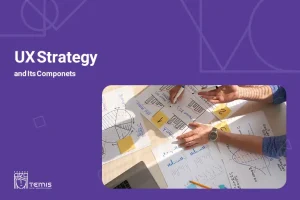There are a lot of terms used in the field of UX design, and it cannot be easy to keep track of them all. User experience (UX) refers to a person’s overall experience when using a product or service. Usability refers to how easily users accomplish their goals when using UI/UX design services. UX design is full of interesting terms and concepts. To work in this field, you’ll need to learn the essential UX terminology. This article will give you a quick guide to some of the most common UX terms.
Table of Contents
What is User Experience Terminology?
User Experience Terminology, often called UX slang or jargon, encompasses a set of terms, phrases, and concepts used in User Experience Design. These terms are designed to standardize communication within the UX community and provide a shared understanding of key principles and processes.
How Does UX Terminology Work?
- Standardization: UX terminology standardizes communication. For instance, when a designer uses terms like “wireframe,” “usability testing,” or “information architecture,” it conveys specific meanings that are universally understood in the UX world.
- Clarity: UX terms clarify complex processes. They help break down intricate design or research methods into concise and digestible concepts. For example, “persona” succinctly describes a detailed user profile.
- Efficiency: Using UX terminology streamlines discussions and documentation. Instead of lengthy explanations, professionals can convey ideas efficiently.
- Alignment: It aligns teams. By establishing concise definitions, UX terms promote consistency across various disciplines within the digital sphere–ensuring efficient communication among stakeholders like designers, developers & even managers.
Top UX Terminology that designers need to know
1-KPIs
KPIs stand for key performance indicators. This study the trends prevailing over a duration and usability patterns and sketch comparisons with competitors. As a UX designer, you’ll often work with KPIs like task success rate, user error rate, and time on task.
2-User experience
User experience (UX) refers to a person’s overall experience when using a product or service. This includes everything from how easy it is to use the product or service to how satisfying it is.
3-Usability
Usability refers to how easily users accomplish their goals when using a product or service. A product or service with good usability is easy to use and understand, and users should be able to achieve their goals without difficulty.
4-Usability testing
Usability testing is a research method that lets us evaluate how easy a product is to use by testing it on a group of representative users. Participants will be asked to complete tasks during usability testing. You’ll observe them as they do this.
5-Lean UX
Lean UX is a combination of agile UX (number 7, in our glossary) and collaborative UX design. This approach focuses on getting early feedback to help make quick design decisions. Lean UX aims to improve and deliver the product in continuous, iterative cycles.
6-Open Source
Anything you stumble upon that is open source is free for public use. You can use it, modify it, and build with it without trouble.
7-Widget
Widgets are elements on the screen that users interact with. For example, social media icons, sliders, buttons, and contact forms, etc.
8-User interface
User interface (UI) refers to the part of a product or service that users interact with to accomplish their goals. This can include things like the buttons on a website or the layout of an app.
9-UI element
A UI element is the building block used in the UI design of apps and websites. You probably encounter buttons, forms, menus, drop-down lists, image carousels, and more, when you use a website or app. These are all good examples of UI elements.
10-Mental Model
A mental model is what the user believes about a product’s capabilities. The more a user’s mental model aligns with a product’s functionality, the easier it will be for them to use it.
11-Back and Front-End Development
Developers often talk about back and front-end development. In software development, the terms front and back-end refer to different product segments.
12-Eye tracking
Eye tracking is used to track users’ eye movements as they look at a website. This gives UIUX designers valuable insight into the areas and elements that attract attention.
13-Grid System
Grid systems allow us to organize content on a screen. Also, they are made up of vertical and horizontal lines that create columns and gutters.
14-User Research
User Research is one of the most obvious UX design terms. This research helps you understand your user better. UX Booth defines user-research as “various investigative techniques used to add context to the design process.”
15-Affinity map
A UX designer uses an affinity map to organize their findings from qualitative user research. This means that data cannot be measured or counted and requires thematic analysis.
16-Interaction design
Interaction design (IxD) is a type of web design that refers to the design of the interactions between users and products or services. This includes things like how users navigate through a website or how they interact with an app.
17-MVP
An MVP, or Minimum Viable Product, refers to the essential features we can launch a product with to get the ball rolling.
18-User Flow
A user flow describes the intended series of steps a user needs to take to complete a goal on a product. They often include a name, steps, and a description of what happens during each step.
19-Material Design
Material Design often called just Material, does Google develop a language for Android devices.
20-SDK
A software development kit, or SDK, contains the tools required to develop products for a specific platform or operating system.
21-Data Science
Numbers can tell us a lot about our users and their needs and help us define how to meet them best. Data Science focuses on making sense of these numbers or data and uncovering valuable insights that help us make better product decisions.
22-Experience Architecture
Experience architecture is a map that lays the outline of a user’s path from the start to the intended goal. It combines several UX and design processes, including information architecture, UI, and UX.
23-Information Architecture
Information architecture (IA) refers to how information is organized and structured within a product or service. This includes the organization of a website’s navigation or an app’s menu structure.
24-SVG
A popular image format in graphic design. It’s scalable vector graphics or SVGs that, are scalable two-dimensional graphics that can be manipulated and animated with code.
25-Microcopy
Here’s a popular one these days. Microcopy is everywhere on interfaces. The small bits of text you see on apps or websites help you navigate it.
26-User journey map
A user journey map is a visualization that depicts all the touchpoints between a user and a product across a given period. It is established for two chief purposes. First, the user journey trace steps users currently take when interacting with a service, design, or product. Second, the user journey establishes a flow visitors can follow when interacting with a design, product, or service.
27-Design Thinking
Design thinking is a 5-stage method for creative problem-solving. There are five phases to design thinking:
- Empathize (with the user)
- Define (the problem)
- Ideate (potential solutions)
- Prototype
- Test
To address difficult UX issues, design thinking is used.
28-Prototype
A prototype is a prototype of the product that we use for testing. You’ll often build different fidelity prototypes during the product design and development.
29-UX writing
UX writing is a fast-growing field within UX. It’s the process of planning and writing all the text found on a digital product interface, to guide the user through the experience. UX writing includes the creation of microcopy.
30-SEO
Search engine optimization increases a website’s visibility in free or organic, search results. It often involves writing useful content on a website around words and phrases users use in searches related to the brand’s product or service.
The Pros of UX Terminology
- Effective Communication: UX terminology fosters clear and precise communication among team members, reducing misunderstandings and misinterpretations.
- Efficiency: It saves time by eliminating the need for lengthy explanations, allowing professionals to discuss ideas and concepts swiftly.
- Standardization: Using a common language standardizes practices within the UX community, ensuring consistency and coherence in the field.
- Learning and Education: It aids in education and learning. Newcomers to UX can grasp foundational concepts more quickly when exposed to standardized terminology.
The Cons of UX Terminology:
- Exclusivity: Excessive reliance on jargon can make UX professionals seem exclusive or elitist, alienating those unfamiliar with the terminology.
- Complexity: Some UX terms can be complex and intimidating to newcomers, potentially discouraging them from entering the field.
- Overuse: Using UX terminology in communication with non-UX colleagues can lead to clarity and satisfaction.
- Evolution: The popularity of UX arises alongside frequently new vocabulary being introduced, leading to confusion.
Conclusion
There are a lot of terms used in the field of UX design, and it can be challenging to keep track of them all. However, understanding these terms is important for designers as they help to create products and services that are easy to use and understand. User Experience Terminology is a crucial aspect of the UX design landscape. It facilitates effective communication, streamlines processes, and aligns teams. However, its benefits should be balanced with an awareness of potential drawbacks, such as exclusivity and complexity. Striking the right balance between using UX terminology for precision and clarity while ensuring inclusivity and accessibility is critical to successful UX design practices.
FAQ
What is UI UX terminology?
A user interface is a matter of interaction between humans and computers. UI design considers how digital products look, feel, and behave for the end user. Good UI creates a delightful user experience, and UX and UI designers work closely together.
What are UX UI elements?
UI elements s are the most integral part of product design, whether web design, mobile, desktop, or AR or VR app. The core building blocks for all products are UI elements.







